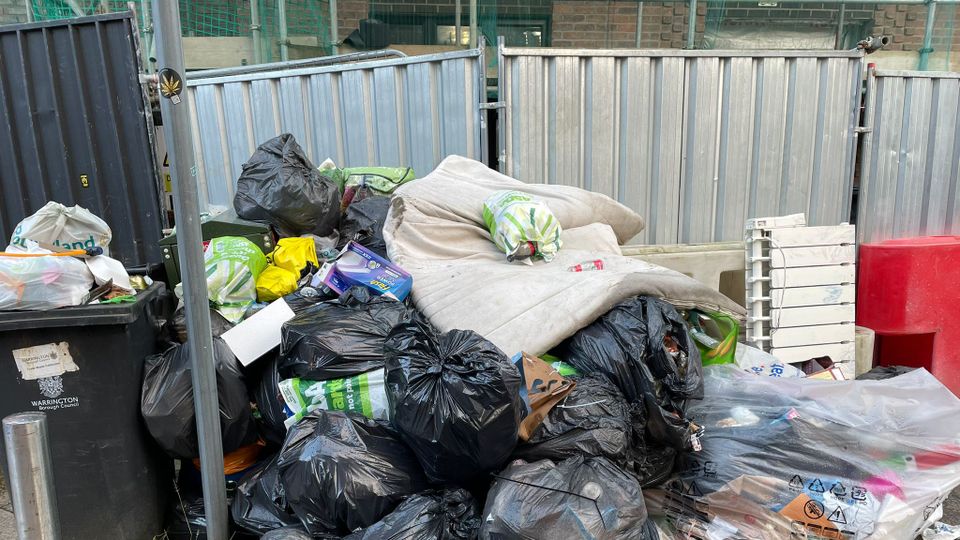Joseph Trevithick
Mon, November 27, 2023

The B61-12 nuclear bomb is now officially in the U.S. stockpile and approved for employment from the B-2A Spirit stealth bomber.
The B61-12 nuclear bomb is now formally in the U.S. stockpile and cleared for operational use on the B-2A Spirit stealth bomber. It's the first U.S. combat aircraft cleared to employ the advanced B61 variant operationally.
U.S. Air Force F-35A Joint Strike Fighters, F-15E Strike Eagles, and F-16C/D Vipers, as well as the service's future B-21A Raider stealth bombers, are also in the process of being certified to employ the B61-12. Some NATO F-35s and F-16s, as well as Germany's swing-wing Tornado combat jets, are also set to be cleared to employ these weapons as part of the alliance's nuclear sharing arrangements.

An unarmed B61-12 test article is seen here on a trailer during a US Air Force test of the weapon on the B-2A in 2023. USAF
The updates about the B61-12, among other items of interest, are contained in a new unclassified Stockpile Stewardship and Management Plan (SSMP) report for the 2024 Fiscal Year that the National Nuclear Security Administration (NNSA) released earlier today. NNSA, part of the Department of Energy, oversees America's nuclear stockpile in coordination with the U.S. military.

A table showing all nuclear weapons currently in U.S. service and their approved delivery platforms, including the B61-12 nuclear bomb, which is now authorized for use on the B-2. NNSA
The B61 series are some of the longest-serving nuclear weapons in the U.S. stockpile. The B61-12 has been slated to eventually supplant existing B61-3, -4, and -7 variants, but more on that later.
The first production B61-12 was completed in late 2021 and the weapons began being delivered to the U.S. military in 2022. The B61-12 program, which is technically a life-extension effort, is currently slated to wrap up in Fiscal Year 2025.
The B61-12 is not an entirely new weapon, and leverages components from multiple existing B61 types while also combining them with various new and improved features. The most significant new capability found on the B61-12, each of which famously costs more than its literal weight in gold, is its precision guidance package. However, this functionality will not be usable when the weapon is employed from F-16s belonging to the Air Force and select NATO member countries, as well as German Tornados. You can read more about all this here.
https://www.youtube.com/watch?v=xhs4VQ9dN3s
The B61-12, which also has small rockets at the rear of the body that spin the bomb to help stabilize it, is a so-called dial-a-yield bomb that can be set to detonate with various degrees of explosive force. Its reported maximum yield setting is 50 kilotons. This is similar, if not identical to what is understood to be the highest yield setting on the B61-4 (45-50 kilotons, depending on the source).
Flight testing of the B61-12 on the B-2, as well as other aircraft, has been ongoing for years now. Back in 2018, when the bomb was still in development, NNSA announced it had completed an initial round of end-to-end qualification flight tests on the B-2.
In June of that year, a B-2 conducted another test demonstrating the ability of the bomber to employ the weapon using the Radar Aided Targeting System (RATS).
"RATS improves weapon guidance accuracy in a Global Positioning System-degraded environment," the Air Force said at the time.
"The integration of RATS allows the B-2 to fully employ the B-61 mod 12 nuclear bomb," Northrop Grumman, the B-2's manufacturer, which remains responsible for the continued modernization and sustainment of the bombers, said in a subsequent press release in August 2022. "RATS is the key element of the nuclear modernization, as GPS may not be available during a bomber task force mission."

A B-2A bomber at Northrop Grumman's facility within the US Air Force's Plant 42 in Palmdale, California. USAF
The timeline for when the B61-12 will be approved for use with the F-35, F-15, F-16, or any NATO aircraft is unclear. NNSA and the U.S. Air Force have previously announced initial certification of the B61-12 on the F-15E and the F-35A. The Royal Netherlands Air Force publicly announced just earlier this month that it had reached a similar milestone with its F-35As.
https://www.youtube.com/watch?v=P1JGe1jj9u0
NNSA's new SSMP report says the B-2's nuclear armament options also still include the B61-7, B61-11, and B83-1 nuclear bombs. The Spirit is actually currently the only aircraft approved to employ any of these bombs. The B61-7 is a higher-yield variant of the B61 family, which can reportedly be set to detonate with a force of up to 400 kilotons. The B61-11 is a highly specialized deep-penetrating version with a maximum yield similar, if not the same as the B61-7. You can read more about the entire B61 family in detail in this past War Zone feature.
The B83-1 is a completely different design with a megaton-class maximum yield.
The B61-11 and B83-1 are primarily intended to be utilized against deeply buried and otherwise hardened high-value targets, such as strategic command and control bunkers and missile silos. President Barack Obama's administration had moved to retire the B83-1 completely, a decision that was then reversed under President Donald Trump.

An inert B83 nuclear bomb. DOD
President Joe Biden's "2022 Nuclear Posture Review directed the retirement of the B83-1" again, but "specific details of the B83-1 retirement and dismantlement plan remain classified," according to NNSA's latest SSMP report.
There had previously been discussion about the possibility of the B61-12 replacing the B61-11 and the B83-1 through its ability to focus the full brunt of its lower-yield payload more precisely thanks to its guidance kit and spin stabilization. However, that idea now looks to have given way to a new version of the B61 with all the new and improved features of the B61-12, but a maximum yield equivalent to that of the B61-7. The Pentagon announced its intention to develop this B61 variant, tentatively dubbed the B61-13, last month.
"The B61-13 will provide the President with additional options against certain harder and
large-area military targets, even while the Department works to retire legacy systems
such as the B83-1 and the B61-7," an official fact sheet explained. No mention was made of any plans to retire the B61-11.
https://twitter.com/Casillic/status/1470605862406348805
The B61-13 plan, which still requires approval from Congress, would also see the expected stockpile of B61-12s shrink to some degree. The balance would, instead, be made up of some number of higher-yield -13 versions. The total numbers of B61-12s and B61-13s the U.S. military wants to acquire under this new course of action are classified. You can read more about what is known about the B61-13 and the reasoning behind its proposed development and acquisition here.
All of this will also have impacts on what nuclear bombs are available in the future for the Air Force's forthcoming B-21A bombers. The Raiders will likely be able to employ the same slate of nuclear bombs, as long as they're still in the stockpile, as the B-2A. The B61-13 is also expected to be for U.S. military use only, unlike the B61-12. The elimination of the B83-1 and B61-7 would leave only B61-11, 12, and 13s as the only nuclear gravity bombs in the U.S. stockpile at all.
It's also worth noting that the B-52H is no longer authorized to carry any nuclear gravity bombs of any type, with the understanding that it is too vulnerable to actually get to the kind of heavily defended targets against which they would be employed. Instead, the only known current and future nuclear weapon options for those bombers, which are set to keep flying at least into the 2040s with the help of new engines and other major upgrades, will be nuclear-tipped cruise missiles. The existing AGM-86B Air Launched Cruise Missile (ALCM) will eventually be replaced by the more capable AGM-181A Long Range Stand-Off (LRSO) cruise missile. LRSO is expected to enter service sometime in the 2030s and will also be integrated onto the B-21A.
https://www.youtube.com/watch?v=qu03xx2o_vs
Altogether, what the exact mix of nuclear weapons available for employment from U.S. Air Force aircraft, as well as those belonging to select NATO partners, will be in the 2030s remains to be seen.
What we do know is that the B61-12 is now officially in the U.S. stockpile and that B-2 stealth bombers can drop them in anger.
Let's hope this capability is never tested in combat.
Contact the author: joe@thedrive.com
US defence tour of RAF site hints at new nuclear weapons deal
Tony Diver
Tue, November 28, 2023

The US Deputy Secretary of Defense Kathleen Hicks visits RAF Lakenheath
The US deputy defence secretary has been given a guided tour of an RAF base thought to be the destination of the first American nuclear weapons on UK soil for 15 years.
Kathleen Hicks visited RAF Lakenheath on Tuesday for a tour of “infrastructure improvements”, on a site where the US government is planning a £39.5 million dormitory for troops.
US budget documents said the site was for “surety”, jargon used by the Pentagon to describe operations related to nuclear weapons, and would be constructed next year.
Both the Ministry of Defence (MoD) and the US Department of Defense have refused to comment on whether the Suffolk base will become home to the first American nuclear weapons in the UK since 2008, when 110 warheads were removed.
But Ms Hicks’s visit is the latest indication that the site has major strategic importance to the US Air Force, which is in charge of storing and maintaining the weapons.
Eric Pahon, a Pentagon spokesman, said Ms Hicks visited the base as part of a three-day trip to the UK to meet with British counterparts.
“While at RAF Lakenheath, deputy secretary toured infrastructure improvements designed to improve base resilience and support for the base’s F-35 squadron and see demonstrations of US capabilities,” he said.
A US budget request earlier this year revealed the Pentagon planned to construct a new 144-bed “surety dormitory” in what is thought to be a high-security bomb-proof bunker for nuclear warheads.
It said the purpose of the building was to “house the increase in enlisted personnel as the result of the potential surety mission”.
A previous document, published in 2022, referred to a Nato project to build new “secure sites and facilities” to store “special weapons” in countries including the UK.
Following reports of the plans, RAF Lakenheath was hit with a planning objection by the Campaign for Nuclear Disarmament (CND), which argued that the MoD and West Suffolk Council failed to conduct an environmental impact assessment for the stationing of nuclear weapons on their former site.
RAF Lakenheath was chosen as one of three sites for US nuclear weapons at the height of the Cold War.
The warheads were removed at the end of George Bush’s administration as the likelihood of nuclear warfare reduced, but may return amid new tensions with Russia.
The Pentagon declined to offer additional detail on Ms Hicks’ visit. The MoD was contacted for comment.
https://issuu.com/foreignpolicyresearchinstitute/docs/fpri_p0035_technical_report_dtra_8_31_23-lp
















